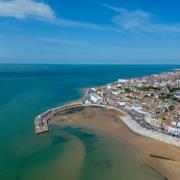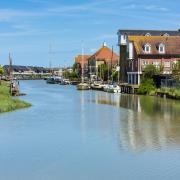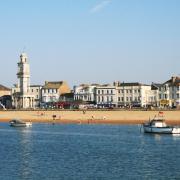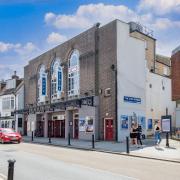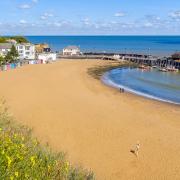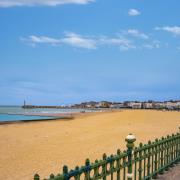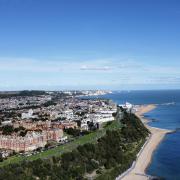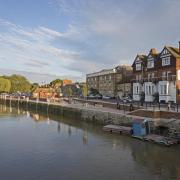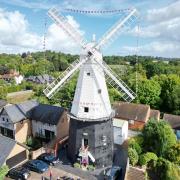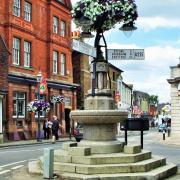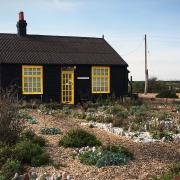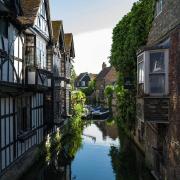We look ahead to the end of lockdown and to a quiet seaside resort we can’t wait to visit again – Herne Bay

History
Set between Whitstable and Margate, and named after the older inland village of Herne, the bay was home to little more than a scattering of fishermen’s cottage until it expanded rapidly around 1830.
As the Victorian fashion for seawater bathing took off, Herne Bay was a natural choice for holidaymakers looking for fresh air away from the busy cities. Between 1881 and 1901 the population almost doubled, and at the turn of the century its nickname was ‘Baby Bay’ because so many nannies and children spent their leisure time there.
The town was laid out with a long promenade and a number of squares and terraces, with all the focus down on the seafront and the main attraction; the wooden pier used by paddle steamers. It would soon be joined by another great landmark, a 75ft clock tower which is celebrated today as the oldest freestanding clock tower in the world.
Meanwhile, the pier has been through a number of transformations over the years. The original wooden structure didn’t survive for long and was replaced with iron versions, extended and later shortened again. Originally an impressive 3633 ft, in its heyday it boasted a theatre, restaurant, pavilion and even trams on the pier. Today its most striking feature is that it has been separated from its pier head, caused when a storm damaged the main neck of the pier in 1978, leaving only a short section remaining.
Like many of our seaside resorts, Herne Bay became less fashionable during the 1960s and 70s and the town went through a period of decline. But in the last decade there’s been a noticeable change. The nostalgia of places like Herne Bay with its simple pleasures such as fish and chips on the seafront and sunbathing on the beach has once again grown in popularity.
Best bits
A trip to the seaside is high on many people’s list of things to do after lockdown. Herne Bay’s biggest attraction is its stunning seafront, with a clean shingle beach, colourful beach huts and public gardens.
Launched five years ago, its Coastal Park stretches five miles from Hampton to Reculver, protecting this pristine piece of Kentish coastline for future generations to cherish and enjoy.
Along the seafront you can find the town’s main landmarks: the pier, clock tower and bandstand. But keep exploring and you’ll also spot a memorial statue to ground-breaking pilot Amy Johnson, looking out to where her plane crashed in 1941, and the perfectly manicured Waltrop Gardens.
If it’s not too windy, take a wild walk along Neptune’s Arm, the offshore breakwater that protects the bay from flooding. Slowly regaining its position as Herne Bay’s top landmark is its pier. Having undergone careful renovation and with further regeneration planned, it’s now home to a Helter Skelter, traditional rides and amusements, and the Herne Bay Village of tiny retail huts and food stalls.
Herne Bay is also becoming known for its independent cafés, restaurants, pubs and shops. Although lockdown hit these small businesses hard, there is a supportive community ensuring that as many of them as possible are saved.
When it comes to culture, the town has the King’s Hall theatre and concert venue, Herne Bay Little Theatre and the Kavanagh Cinema, as well as a community arts centre called Beach Creative and the quirky little Seaside Museum. Keep up to date with what’s going on in Herne Bay by following ‘Hello Herne Bay’ on Facebook.
Developments
It’s surprising that Herne Bay hasn’t yet seen the kind of regeneration and property boom enjoyed by its closest neighbours, but that’s part of the magic of this very special place.
Lacking their crowds of day-trippers and second homeowners, it still feels like a charmingly old-fashioned British seaside resort. However, all that is likely to change.
There are plans to further regenerate the pier, possibly even extending it, while construction of a multi-million pound project to completely change the seafront was due to begin this summer – although it remains to be seen what effect the country’s lockdown will have on the schedule.
Canterbury City Council was also planning to convert the former Tivoli arcade in Central Parade into a shop, studios and 33 homes.
Three years ago, the council’s Local Plan was voted through, earmarking four sites for around 3,000 new homes in Herne Bay – at Strode Farm, Greenhill, Hillborough and the former golf course.
With so much inevitably up in the air this year, it will be interesting to see which plans go ahead and when. Keep an eye on any movement at: canterbury.gov.uk/planning.
Property prices
This time last year Herne Bay was being tipped as Kent’s next big property hotspot, but the world has changed dramatically and the property market is one of the greatest unknowns. Prices currently start at around £130,000 for a one-bedroom flat, with two-bed apartments from £140,000. Three-bed semis are on the market for anything between £260,000 and £375,000. At the top of the market are large detached houses up to £850,000.
Getting there
On the coast between Whitstable and Margate, Herne Bay is only eight miles from Canterbury. Well connected by rail, trains into London take around one hour and 20 minutes. For drivers, it’s accessed via the A229, which joins the M2.




